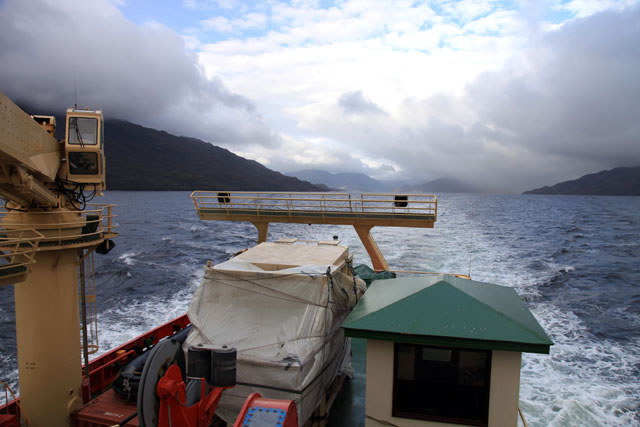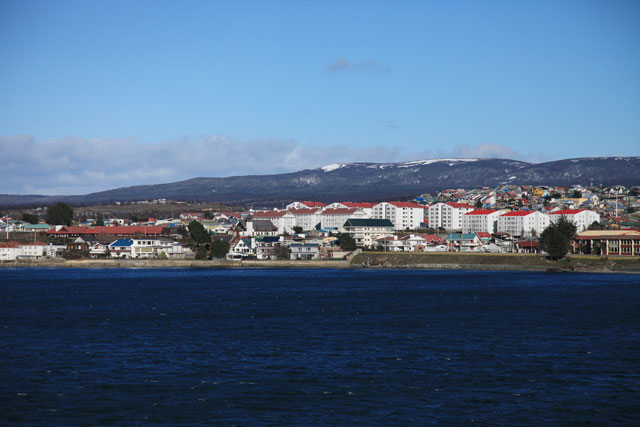|
Passing the seasonsVoyage to southern hemisphere finds winter awaitingPosted November 21, 2012
The time for the research vessel Laurence M Gould’s The more immediate task was to make the long voyage from Louisiana to Chile, and to do so with enough time left over to allow for yet another cargo swap. Passengers embarking for the trip to Anvers Island would also have to be dealt with. The first leg of the journey involved crossing the Caribbean in August. The water churned up by the ship’s two large propellers was the color of lapis, trimmed with foam of turquoise and white. Sea and sky were beautiful, but the heat oppressive. Not surprisingly, the same was true in Panama. These are not latitudes where one expects a chilly day. Steaming into the Pacific placed Colombia squarely on the port beam, making the equator our next milestone. No need to check any forecast: continued heat was the order of the day. Given the place and month, none of this was unexpected. But things were about to change. Crossing into the southern hemisphere meant that the vessel would, in an instant, sail from summer into winter. That occurred someplace between Ecuador and the Galapagos Islands. Neither actually came into view, but knowledge of their proximity was sufficient to elicit imaginary visits. Daydreams of marine iguanas sunning themselves on surf-swept rocks also seemed the order of the day. But while the iguanas were mere figments, something very real also lurked over the horizon. A change was coming. The week that followed brought calm seas and sunny days, but surprisingly mild temperatures. No “dog days” here; the blistering heat was gone. Perhaps it really was winter’s influence, or perhaps a debt was owed to the Humboldt Current. The Humboldt is one of the world’s great ocean features. It carries cold, nutrient-rich water northward from the Antarctic; so rich that as much as 20 percent of the world’s fish catch occurs there. The cold water also affects the temperature and precipitation regimes of Chile, Peru and Ecuador. For those onboard the Gould, the change was most welcome. It was as though the ship had entered a transition zone between two extremes — something of a faux autumn. The seasons are generally thought of as events that exist in time. We subdivide our years by their passing, a practice that makes perfect sense — assuming that one does not move around too much. In reality, a season is not merely a fraction of a year. It’s also a function of latitude and the Earth’s progression around the sun. Recognizing this helps to explain something peculiar: the Gould’s southbound journey seemed a passage through the seasons. Peru was the next subject of imagined visits, though it held sway only briefly. Dreams of Machu Picchu and the Cordillera Blanca faded as the ship approached Chile’s northern border, even though it was clear to all that the end of our journey was still some way off. That we were not nearing journey’s end can be explained by a glance at a globe. Doing so confirms why Chile is described as the paradigmatic example of an elongated state. That’s what geographers call a country that, in simple terms, is “long and thin.” In rough terms, Chile extends from 18.5 degrees south latitude, to 56 degrees south latitude. The long and the short of it was that there was still a long way to go. The ocean had been kind to the Gould thus far, but Chilean waters harbored change. It was subtle at first: a stiffening breeze and playful swells on a sea only slightly less blue. Perhaps all of this would pass, and tomorrow would offer a return to azure water. But the morning revealed an even darker ocean, and white caps of worsening temper. A cold wind was gathering out there somewhere — one determined to shake this vessel from the ambivalence that comes with mild weather and smooth sailing. The ocean was by no means violent on any leg of our journey, but the small ship with its rotund icebreaker hull does not respond well to even meager swells. This is no sleek frigate capable of slicing through tempestuous walls of water. It’s stout and it’s brutish for its modest displacement, because that’s what’s required for the sojourn to Palmer Station. So it rolls and it lurches in a manner reminiscent of a child’s fishing bobber, even in moderate seas. Those on board take guarded steps and use the ubiquitous handrails at such times, and look forward to a break from the winds that rouse the water. The roughest part of the trip commenced as the vessel passed between mainland Chile and the Archipiélego Juan Fernández (about 33.5 degrees south latitude). This is where Scotsman Alexander Selkirk was marooned for four years, becoming the inspiration for Daniel Defoe’s Robinson Crusoe. Selkirk’s unlikely exploits inevitably elicit yet another flight of fancy, but one abruptly purged by a sudden lunge to starboard. 1 2 Next |



For USAP Participants |
For The Public |
For Researchers and EducatorsContact UsNational Science FoundationOffice of Polar Programs Geosciences Directorate 2415 Eisenhower Avenue, Suite W7100 Alexandria, VA 22314 Sign up for the NSF Office of Polar Programs newsletter and events. Feedback Form |




